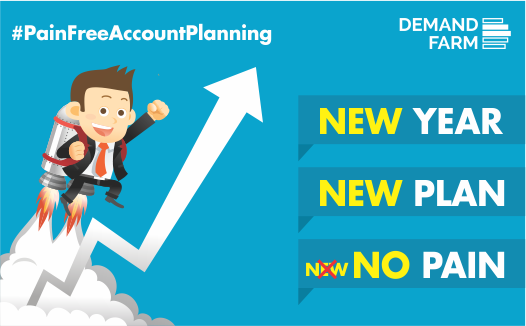Fly High Even During A Recession

Make your Key Account Management strategy work even during an economic downturn The recession is coming down on us faster than any of us expected. This unforeseen economic downturn is likely to have impacted your 2022 account plans. While post-covid ‘Land & Expand’ was the favorite approach to growing Key Accounts, the recession has resulted in additional dimensions being added to the Land & Expand strategy. This article takes you through on how to get back on track with your key accounts, lay the foundation for regaining stability and continuing growth. Based on our interactions with existing enterprise accounts and knowledge of the challenges faced by them, this article runs you through how you can recalibrate your account plans for 2023 in light of the recession. What’s Going on in the Market Right Now? Right now, the market looks a bit bleak. You might be experiencing the following situation 1) Stalled contracts: Customers you were pursuing might have stalled contracts in fear of the recession and due to lack of funds. 2) Losing your Champions: Employees are getting furloughed due to the economic condition. They might have been the champions in your organization and this can negatively impact you. 3) Lack of resources: As you lose a percentage of your workforce, there are fewer people to take care of your key accounts. This can diminish the attention that should be given to the customers who bring in the most revenue. 4) Lack of focus: Diverted resources, loss in workforce and uncertainties surrounding current economic conditions directly affect the status of your key accounts. The sales concentration that key accounts should get is negatively impacted in the chaos of the situation. When times get tight, it is more important than ever to focus on your existing customers, to invest in them and solidify relationships you already have. Impact of the Economic Downturn The IMF projects that world economic growth will slow to 3.2% this year, down from 6.1% in 2021 (Forrester Research Inc. 2022). An economic downturn comes with its own set of issues for both your organization and yourself. Budgets are now tighter and expenditures are highly restricted. High-risk of churn – you could lose a major customer at any time. Customers will be looking to cut – costs and might not want to purchase your service/ product. Existing customers might not want to renew. Money is often lost by spending it on attracting new customers. Proving ROI becomes complicated. However, in the 2022 Forrester Research Inc. report titled ‘2023 Planning Isn’t Business As Usual’, leaders do not want to slow down tech investments. 67% of leaders expected budget increases when it came to technology. Being mindful of the impact of a downturn on your organization requires embracing consequences while at the same time rethinking your strategies. Winning the CFOs approval: How to Present RoI of a Key Account Management Software Keep Calm and Weather the Storm How do you deal with such uncertain economic times both as an organization and as an individual? 1) Become trusted advisors With a recession ahead, customers might be looking for ways to cut costs. To avoid being part of external vendors who could get cut, you should make yourself invaluable. The first step in making yourself invaluable is to become more than a vendor. You need to become a trusted advisor by becoming a strategic partner. Knowing the customer as much as possible is vital to this. 2) Know your client In order to become a trusted advisor and a beneficial partner, you should know all details about your client including how they work, their likes and dislikes. Analyzing what strategies have worked in the past for them, what hasn’t and what are their goals for the future also ensures you understand your client completely. Knowing both their short-term and long-term goals is important for providing strategic solutions. Proactively following up with clients is also necessary to help them reach their goals. 3) Build on Strategic Relationships A trusted key account manager should work on contingency plans and long-term strategies with their customers. So when the recession begins to hit, the customer is well-prepared to face the economic downturn. The question remains how do you build such strategic relationships with your customers? The answer lies in key account management. Seven Sure-fire Ways to Recession Proof your Key Account Management strategy 1) Build stronger processes Build a strong plan of action for your top strategic accounts or key accounts. Assess your client portfolio and prioritize based on current revenue and growth potential to develop a well-defined strategy moving forward. When tighter budgets and higher scrutiny becomes the norm, don’t lose out on defending and growing your key accounts by building a strong foundational framework of key account management. A few aspects of your KAM model ought to be equipped with: Ability to get a complete view of stakeholders in your key accounts Facility to manage relationships within them at scale Ability to track all activities between your company and the customer 2) Strengthen governance Ensure that there is real-time performance data and trend analysis to strengthen governance. Ideally, executive dashboards and reports with intuitive drill-downs are essential for enhanced governance in your key accounts. 3) Increase Collaboration Increasing collaboration among the sales teams and account teams helps build a strong support system both internally and externally. This can help engage with your customer in a meaningful manner across the board. This will also make certain you dig deeper into existing customer relationships so that you can stay on top of their needs and relevant to their long-term goals. 4) Relationships are even more important Nobody wants to receive bad news, and that can hold you back from being realistic with your customers. It is definitely easier to speak with clients and stakeholders when you are delivering good news. But, as trusted advisors, key customers rely on you for recommendations and solutions to the challenges they are currently facing.
The Future of Key Account Management Report – A Global CSO study by DemandFarm

Key Account Management has always been a critical component of every B2B organization, given that in most cases Key Accounts contribute upwards of 60% of their overall revenues. As businesses become more global and complex, the role of strategic account management will evolve further. As companies strive to increase market share and grow their customer base, making a “shift” towards Digital KAM will help them achieve these goals. DemandFarm, with insights from the 2022 CSO Survey conducted across USA, Europe and Asia-Pacific regions gathered 1000+ responses from sales leaders covering the trends, skills, tools, and strategies to understand the future of KAM and its changing landscape. Download the Research Report to uncover the future of KAM and its changing landscape.
√ New Year √ New Plan ? New Pain

It is the end of the year, and before we can enjoy the Christmas bonus and stuffed turkey, Key Account Management professionals have the unenviable task of reviewing the past year and creating account plans for 2017. You have probably been doing it every year, so you have a basis or a template, and all you need to do is update that, add projections, etc. But is it that simple? It is not just a sales projection; it is an account plan. We can think of dozens of questions you need to answer while planning for a key account and you can probably add on to the list as well. So where and how do you begin? Before you dig out last year’s account plan formats, the old ppts or excel sheets ask yourself these questions; “How are KAM professionals in competitor organizations and other industries preparing their account plans? Is my old method the best, most efficient way? Is there a way to make account planning easier, or to create a more thorough, robust account plan?” If you have paused to think about these questions, your first step has been in the right direction! Our experience providing KAM technology for IT service industry clients has shown us that they face challenges that are often uniquely different from those faced by other B2B industries. As we examine these challenges, we reflect on how they affect account management and how technology can ease the pain and assist with account planning. Service, an Intangible Product Organizations that have a tangible product can easily demonstrate and communicate the uses and benefits of the product. Therefore they depend primarily on the product quality and back that up or accentuate it with a brand. In contrast, the service industry has an intangible product whose benefits are not as easily demonstrable. Therefore trust or a brand name and depending on relationships and people is what attracts and retains customers. One of the benefits of KAM technology is its ability to calculate the relationships mapping strength of key accounts. Another is the convenience of having a unified view of organizational hierarchy, showing all people related to the key account, in the client’s firm and yours. Making an account plan is easy if you use all the relationship related features offered by technology; use CRM as a base, drag and drop to create a key account’s organizational hierarchy, assign a status to people based on their affinity for your company and services, plan periodic interactions between people from different hierarchical levels and more. The result, #painfreeaccountplanning, and the confidence that it provides metrics on relationship strength and throws up warning indicators as well. This year you can use specialized key account management technology to create a well-articulated account plan, one that converts relationships from hurdles into the backbone and strength of marketing. Interaction between the buyer and seller Research by Rawson, Duncan, and Jones found that customers of service industries judged satisfaction based on cumulative experiences across multiple touchpoints. In other words, each time the customer interacts with you, be it the receptionist at your head office, the automated caller menu and every client service assistant and manager, he or she is judging the experience and consciously or unconsciously rating his or her experience. A product has only one or at best a few touchpoints between the seller and the buyer. On the other hand, providing a service has multiple touchpoints throughout the life cycle of the service contract. Therefore more white space opportunities to delight or disgust the customer! Knowing this, who wouldn’t want to track customer interactions in a systematic and objective way? The solution- use KAM technology to collaborate with internal stakeholders, enumerate mutually agreed expectations and targets, and create a unified action plan. This is your chance to plan systematically and make each touchpoint an opportunity to delight your strategic account management. Make or Buy Conundrum In keeping with the holiday season, imagine you are a manufacturer of chocolates who finds he has the insufficient inventory to meet demand. Would you think of buying a cocoa plantation to increase your raw material supply, or of manufacturing a machine to temper chocolate? Probably not. You are most likely to approach sellers and buy them outright, even if you had to increase production at the cost of lower margins. But what if an IT service provider approached you with software that could better estimate cyclic consumption and enable you to plan production and inventories such that you would not face seasonal crunches? Would you consider it right now, put it off till after the holiday season production rush, wonder if the investment would really pay off or think about whether you could do something similar in-house? If you said yes to either of the last two options, you have just highlighted the challenge of selling services. Services, particularly IT services, are rarely perceived as immediate requirements. Their investment-outcome ratio is endlessly debated and often an in-house, home-grown alternative is chosen. Can you overcome the make or buy conundrum? One way to do this is to sell solutions, not services. KAM technology enables you to systematically catalog client requirements, understand the client’s end goal and align your company’s products and services to offer solutions accordingly. While key account planning this year, you can use technology to create a whitespace analysis and depending on the results, design and offer the right solutions to a key account. Creating new avenues of business from an existing client not only adds to your revenue, but it also makes the client feel valued because you are proactive in helping them meet their end goal. Customized versus Standardized Products tend to have standard specifications. Any variations or customizations are generally made at the request of customers. Hence the cost of customization is relatively easy to calculate and is often passed on to the customer. But when you sell a service as a solution, not a product, you have to customize the service